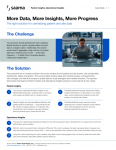New EMA trial transparency policy may mean higher legal costs for CROs say campaigners

Following extensive consultations held over the past 18 months, the EMA Management Board unanimously adopted the new policy at its meeting late last week.
“The adoption of this policy sets a new standard for transparency in public health and pharmaceutical research and development,” said Guido Rasi, EMA Executive Director, in a statement. “This unprecedented level of access to clinical reports will benefit patients, healthcare professionals, academia and industry.”
The new EMA policy will serve as a complementary tool ahead of the implementation of the new EU Clinical Trials Regulation that will come into force around May 2016.
Controversy Avoided?
Academics, researchers and the public will be able to re-assess data sets as all of the data will be browsable after pressure from scientists forced the agency to reverse a policy that would’ve restricted where and how the data could’ve been viewed from.
However, some are concerned that the policy still doesn’t go far enough in terms of transparency and what’s included in the releases.
Ben Goldacre of the AllTrials campaign, criticized the policy for a number of reasons: “Firstly, the EMA records are woefully incomplete for informed decision making: EMA only holds CSRs [clinical study reports] for a small proportion of all the trials done on all the medicines we use today. We need a radical overhaul giving retrospective transparency on all CSRs from industry, and clear transparency on methods and results for all trials done by academics.
“Secondly, this policy does nothing to move forward on the safe sharing of individual patient data – whilst respecting patient privacy – which was promised by EMA in 2012. Lastly, there are serious concerns around the redactions process. For this, we can only go on recent performance, which is not encouraging. EMA reached an agreement this year with AbbVie to censor information on protocol changes from the public release of a CSR. Protocol changes in a trial are precisely the kind of information that researchers need, to make an informed decision about whether that trial was a “fair test” of the treatment. It is hard to see how it is justifiable to hide protocol changes, in a trial from eight years ago, on over-riding grounds of commercial confidentiality,” Goldacre said.
According to the EMA, the main concerns in terms of the release of data, and perhaps the reason behind their decision to place a number of restrictions on the release of confidential data stemmed from:
• The concept of commercially confidential information and the protection from unfair
commercial use;
• Protecting patient confidentiality; and
• The concept of raw data.
Phased Implementation
The first implementation phase will begin Jan. 1, and once a medicine has received a marketing authorisation, EMA will publish the clinical reports. For extensions of indications of already approved medicines, the agency will give access to clinical reports for applications submitted as of July 2015.
Farther into the future, EMA plans to also make available individual patient data. To address the various legal and technical issues linked with the access to patient data, the Agency will first consult patients, healthcare professionals, academia and industry.
Impact on CROs
Although ACRO previously told us that the new policy won’t have a significant impact on CROs because the information is owned by sponsors, the All Trials campaign notes that the Terms of Use contract researchers “must sign allows trial sponsors to take direct legal action against researchers for possible violation of the Terms of Use.”
CROs may be “made vulnerable to protracted legal battles with large companies which will introduce a new and unpredictable risk of high legal costs into routine academic work, effectively chilling researchers’ ability to use information relevant to patient care,” according to All Trials.
























